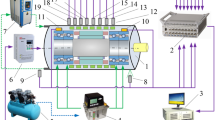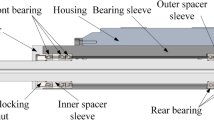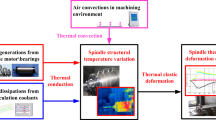Abstract
For thermal perception and control onto spindle bearings without spindle/bearing structural modifications for built-in thermal sensors, this paper proposes a thermal simulation speculation-based active coolant control strategy onto spindle bearings, for spindle accuracy guarantee. Firstly, numerical simulation technology is adopted to construct thermal collection of spindle bearings influenced by coolants. Secondly, this collection is utilized as the basis for ELM speculation modeling for bearing thermal behaviors. Eventually, the previous active coolant strategy is modified to be equipped with the model above for the speculation perception (according to the detectable spindle working parameters) and active control realization onto thermal behaviors of spindle bearings. It is verified by experiment and simulation that the thermal simulation speculation-based active coolant strategy is more advantageous than the previous strategy, in thermal stabilization and accuracy guarantee of motorized spindle unit. Besides, the power ratio between coolant heat dissipation and bearing heat generation is suggested to be 1.15:1 for a sufficient thermal balance of spindle bearings, which brings the design guidance onto cooling capacity/strategy of recirculation cooling equipment for motorized spindle unit.












Similar content being viewed by others
Availability of data and material
Data generated or analyzed in this study are available.
Abbreviations
- ρ oil_sol /ρ oil :
-
Density of coolant oil or solid/density of coolant oil (kg/m3)
- k oil_sol :
-
Thermal conductivity of coolant oil or solid (W/(m·K))
- H en :
-
Energy content per unit mass (J)
- p :
-
Pressure (Pa)
- \( \overrightarrow{v} \)/\( \overset{=}{\tau } \) :
-
Velocity vector/stress tensor
- S h :
-
Heat generation power of volumetric heat source (W)
- u/ v/ w :
-
Coolant flowing velocity on X/Y/Z direction (m/s)
- \( \nabla \bullet \left(\overset{=}{\tau}\overrightarrow{v}\right) \) :
-
Viscous power dissipation of flowing coolant (W)
- ∇ • (k ∇ T):
-
Heat transfer among solid, flowing coolant, and ambient air (W)
- Φ b/Φ m :
-
Heat generation power of spindle bearing/motor (W)
- n :
-
Spindle rotating speed (RPM)
- M 0/M 1 :
-
Bearing frictional torque caused by bearing lubricant viscosity/applied force (Nmm)
- f 0/f 1 :
-
Factor related to the type, structure, force, and lubrication of bearings
- ν 0 :
-
Kinematics viscosity of lubricant (mm2/s)
- F β :
-
Applied force load onto bearing (N)
- D m :
-
Mean diameter of bearing (mm)
- P h/P CU/P f :
-
Power of motor magnet/electric/mechanical loss (W)
- C :
-
Constant value related to electrical steel grades
- f :
-
Magnetizing frequency (s−1)
- B max :
-
Maximum magnetic flux density (T)
- t :
-
Thickness of silicon steel sheet (m)
- ρ/ρ air/ρ coo :
-
Density of iron core/air/coolant (kg/m3)
- γ c :
-
Resistivity of iron core (Ω)
- I :
-
Current (A)
- ρ C :
-
Resistivity of a conductor (Ω)
- L :
-
Length of a conductor (m)
- S :
-
Sectional area of a conductor (m2)
- C ′ :
-
Frictional coefficient
- R f/L f :
-
Outer radius/length of rotor (m)
- ω :
-
Angular velocity of rotor (rad/s)
- h f/n :
-
Coefficient of forced/natural convection heat transfer (W/(m2K))
- Nu :
-
Nusselt number
- λ :
-
Thermal conductivity of air (W/(m·K))
- d e/l e :
-
Diameter/length of spindle part (m)
- Re/Pr:
-
Reynolds number/Prandtl number of air
- u air :
-
Flow velocity of air (m/s)
- ν air :
-
Kinematics viscosity of air (m2/s)
- P 1–4 :
-
Design variables 1–4 for optimization
- Te/Ts :
-
Experimental/simulated temperature data of motorized spindle unit (°C)
- T coo _ fbg(bb)/T out _ fbg(bb) :
-
Coolant supply/output temperature for spindle front bearing group (back bearing) (°C)
- T ssb _ fbg(bb) :
-
Spindle shell temperature nearby front bearing group (back bearing) (°C)
- T fbg(bb) :
-
Temperature of spindle front bearing group (back bearing) (°C)
- a r/b r :
-
Learning parameters of SLFN rth hidden nodes
- β r :
-
SLFN rth output weight
- x :
-
Input vector for SLFN
- G(a r, b r, x):
-
Activation function denoting output of rth hidden nodes ar/br with respect to input x
- t :
-
SLFN output variable
- L :
-
Number of SLFN hidden nodes
- M :
-
Number of spindle thermal simulations in collection
- N :
-
Moment number of each spindle transient thermal simulation
- c coo :
-
Coolant special heat (J/(kg·K))
- Q coo :
-
Coolant supply volume rate (L/min)
- Φ coo :
-
Coolant heat dissipation (W)
References
Liu T, Gao WG, Zhang DW, Zhang YF, Chang WF, Liang CM (2017) Analytical modeling for thermal errors of motorized spindle unit. Int J Mach Tools Manuf 112:53–70
Chou C, DeBra DB (1990) Liquid temperature control for precision tools. CIRP Ann Manuf Technol 39:535–543
Abele E, Altintas Y, Brecher C (2010) Machine tool spindle units. CIRP Ann Manuf Technol 59:781–802
Cao HR, Zhang XW, Chen XF (2017) The concept and progress of intelligent spindles: a review. Int J Mach Tools Manuf 112:21–52
Creighton E, Honegger A, Tulsian A, Mukhopadhyay D (2010) Analysis of thermal errors in a high-speed micro-milling spindle. Int J Mach Tools Manuf 50(4):386–393
Han J, Wang LP, Yu LQ (2010) Modeling and estimating thermal error in precision machine spindles. Appl Mech Mater 34:507–511
Holkup T, Cao H, Kolar P, Altintas Y, Zeleny J (2010) Thermo-mechanical model of spindles. CIRP Ann Manuf Technol 59(1):365–368
Li DX, Feng PF, Zhang JF, Wu ZJ, Yu DW (2014) Calculation method of convective heat transfer coefficients for thermal simulation of a spindle system based on RBF neural network. Int J Adv Manuf Technol 70(5):1445–1454
Chen DJ, Bonis M, Zhang FH, Dong S (2010) Thermal error of a hydrostatic spindle. Precis Eng 35(3):512–520
Su H, Lu LH, Liang YC, Zhang Q, Sun YZ (2014) Thermal analysis of the hydrostatic spindle system by finite volume element method. Int J Adv Manuf Technol 71(9):1949–1959
Liu ZF, Pan MH, Zhang AP, Zhao YS, Yang Y, Ma CY (2015) Thermal characteristic analysis of high-speed motorized spindle system based on thermal contact resistance and thermal-conduction resistance. Int J Adv Manuf Technol 76(9):1913–1926
Zivkovic A, Zeljkovic M, Tabakovic S, Milojevic Z (2015) Mathematical modeling and experimental testing of high-speed spindle behavior. Int J Adv Manuf Technol 77(5):1071–1086
Lee J, Kim DH, Lee CM (2015) A study on the thermal characteristics and experiments of high-speed spindle for machine tools. Int J Precis Eng Manuf 16(2):293–299
Ma C, Yang J, Zhao L, Mei XS, Shi H (2015) Simulation and experimental study on the thermally induced deformations of high-speed spindle system. Appl Therm Eng 86:251–268
Huang JH, Than VT, Ngo TT, Wang CC (2016) An inverse method for estimating heat sources in a high speed spindle. Appl Therm Eng 105:65–76
Zheng DX, Chen WF, Li MM (2018) An optimized thermal network model to estimate thermal performances on a pair of angular contact ball bearings under oil-air lubrication. Appl Therm Eng 131:328–339
Liu T, Gao WG, Tian YL, Zhang HJ, Chang WF, Mao K, Zhang DW (2015) A differentiated multi-loops bath recirculation system for precision machine tools. Appl Therm Eng 76c:54–63
Liu T, Gao WG, Tian YL, Zhang DW, Zhang YF, Chang WF (2017) Power matching based dissipation strategy onto spindle heat generations. Appl Therm Eng 113:499–507
Zhang YF, Wang P, Liu T, Gao WG, Chang WF, Tian YL, Zhang DW (2018) Active and intelligent control onto thermal behaviors of a motorized spindle unit. Int J Adv Manuf Technol 98:3133–3146
Anderson JD (1995) Computational fluid dynamics: the basics with applications. McGraw Hill, New York
Jorgensen BR, Shin YC (1997) Dynamics of machine tool spindle/bearing systems under thermal growth. J Tribol 119(4):875–882
López de Lacalle LN, Lamikiz A (2009) Machine tools for high performance machining. Springer, London
Xu M, Jiang SY, Cai Y (2007) An improved thermal model for machine tool bearings. Int J Mach Tools Manuf 47(1):53–62
Huang GB, Zhu QY, Siew CK (2006) Extreme learning machine: theory and applications. Neurocomputing 70(1–3):489–501
Parkus H (1976) Thermoelasticity. Springer, Vienna
ISO 230-3-2007. Test code for machine tools - Part 3: Determination of thermal effects (Second Edition)
Acknowledgments
The authors acknowledge the Fund of National Nature Science Foundation of China (No. 51775375), Fund of Nature Science Foundation in Tianjin of China (No. 17JCZDJC40300), and Open Fund of Jiangsu Key Laboratory of Precision and Micro-Manufacturing Technology.
Funding
The research was supported by the Fund of National Nature Science Foundation of China (No. 51775375), Fund of Nature Science Foundation in Tianjin of China (No. 17JCZDJC40300), and Open Fund of Jiangsu Key Laboratory of Precision and Micro-Manufacturing Technology.
Author information
Authors and Affiliations
Contributions
Teng Liu is the main contributor to this paper. He finished the thermal simulation modeling of motorized spindle unit and then corrected its thermal loads by optimization method. The aim is to construct the thermal collection of spindle bearings influenced by coolants. Furthermore, he performed the contrasting experiments for this study and finished the handwriting of the manuscript as a whole.
Liang Zhou finished ELM-based speculation modeling for bearing thermal behaviors, and the previous active coolant strategy is then modified by him to be equipped with the ELM model.
Weiguo Gao gave Teng Liu the significant guidance about the thermal simulation modeling method of motorized spindle unit and finished the construction of experimental platform.
Yifan Zhang finished the data analyses about the experimental and simulation results.
Wenfen Chang provided this study with the test platform of motorized spindle unit and gave some valuable suggestions onto the experimental method.
Jianjun Zhang designed the logical structure of the whole manuscript.
Dawei Zhang gave crucial comments onto this work for improving its technical route.
Corresponding author
Ethics declarations
Competing interests
The authors declare that they have no competing interests.
Ethical approval
Not applicable.
Consent to participate
All authors consent to participate in the author team of this submitted manuscript.
Consent to publish
The submitted manuscript is approved by all its authors for publication.
Additional information
Publisher’s note
Springer Nature remains neutral with regard to jurisdictional claims in published maps and institutional affiliations.
Rights and permissions
About this article
Cite this article
Liu, T., Zhou, L., Gao, W. et al. Thermal simulation speculation-based active coolant control onto spindle bearings. Int J Adv Manuf Technol 113, 337–350 (2021). https://doi.org/10.1007/s00170-021-06613-6
Received:
Accepted:
Published:
Issue Date:
DOI: https://doi.org/10.1007/s00170-021-06613-6




